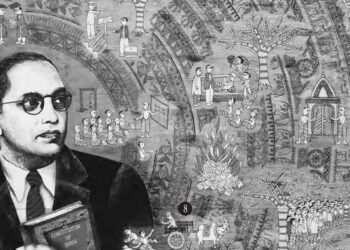Continued from previous issue..
The Muslim invasions of India commenced in the year 1001 A.D. The last wave of these invasions reached Southern India in 1296 A.D. when Allauddin Khilji subjugated the Kingdom of Devagiri. The Muslim conquest of India was really not completed by 1296. The wars of subjugation went on between the Muslim conquerors and the local rulers who though defeated were not reduced. But the point which requires to bear in mind is that during this period of 300 years of Muslim Wars of conquests, India was governed all over by princes who professed the orthodox faith of Bramhanism. Bramhanism beaten and battered by the Muslim Invaders could look to the rulers for support and sustenance and did get it. Buddhism beaten and battered by the Muslim invaders had no such hope. It was an uneared for orphan and it withered in the cold blast of the native rulers and was consumed in the fire lit up by the conquerors.
The Musalaman invaders sacked the Buddhist Universities of Nalanda, Vikramasila, Jagaddala, Odantapuri to name only a few. They raised to the ground Buddhist monasteries with which the country was studded. The Monks fled away in thousands to Nepal, Tibet and other places outside India. A very large number were killed outright by the Muslim commanders. How the Buddhist priesthood perished by the sword of the Muslim invaders has been recorded by the Muslim historians themselves. Summarizing the evidence relating to the slaughter of the Buddhist Monks perpetrated by the Musalman General in the course of his invasion of Bihar in 1197 A.D. Mr. Vincent Smith says: “The Musalman General, who had already made his name a terror by repeated plundering expeditions in Bihar, seized the capital by a daring stroke. The almost contemporary historian met one of the survivors of the attacking party in A.D. 1243, and learned from him that the Fort of Bihar was seized by a party of only two hundred horsemen, who boldly rushed the postern gate and gained possession of the place. Great quantities of plunder were obtained, and the slaughter of the ‘shaven headed Brahmans’ that is to say the Buddhist monks, was so thoroughly completed, that when the victor sought for someone capable of explaining the contents of the books in the libraries of the monasteries, not a living man could be found who was able to read them. ‘It was discovered’ we are told, ‘that the whole of that fortress and city was a college, and in the Hindi tongue they call a college Bihar.”
Such was the slaughter of the Buddhist priesthood perpetrated by the Islamic invaders. The axe was struck at the very root. For by killing the Buddhist priesthood Islam killed Buddhism. This was the greatest disaster that befell the religion of Buddha in India. Religion like any other ideology can be attained only by propaganda. If propaganda fails, religion must disappear. The priestly class, however detestable it may be, is necessary to the sustenance of religion. For it is by its propaganda that religion is kept up. Without the priestly class religion must disappear. The sword of Islam fell heavily upon the priestly class. It perished or it fled outside India. Nobody remained to keep the flame of Buddhism burning.
there is this difference between the constitution of the two religions and the difference is so great that it contains the whole reason why Brahmanism survived the attack of Islam and why Buddhism did not. This difference relates to the constitution of the clergy.
It may be said that the same thing must have happened to the Brahminic priesthood. It is possible, though not to the same extent. But there is this difference between the constitution of the two religions and the difference is so great that it contains the whole reason why Brahmanism survived the attack of Islam and why Buddhism did not. This difference relates to the constitution of the clergy.
The Brahmanic priesthood has a most elaborate organization. A clear and succinct account of it has been given by the late Sir Ramakrishna Bhandarkar in the pages of the Indian Antiquary.
‘Every Brahmanic family,’ he writes, ‘is devoted to the study of a particular Veda, and a particular Sakha (recession) of a Veda; and the domestic rites of the family are performed according to the ritual described in the Sutra connected with that Veda. The study consists in getting by heart the books forming the particular Veda. In Northern India, where the predominant Veda is the White Yagush and the Sakha that of the Madhyandinas, this study has almost died out, except at Banaras, where Brahmanic families from all parts of India are settled. It prevails to some extent in Gujarat, but to a much greater extent in the Maratha country; and in Tailangana there is a large number of Brahmans who still devote their life to this study. Numbers of these go about to all parts of the country in search of dakshina (fee, alms), and all well-to-do natives patronize them according to their means, by getting them to repeat portions of their Veda, which is mostly the Black Yagush, with Apastamba for their Sutra. Hardly a week passes here in Bombay in which no Tailangana Brahman comes to me to ask for dakshina. On each occasion I get the men to repeat what they have learned, and compare it with the printed texts in my possession.
Courtesy: Dr. Babasaheb Ambedkar Writings and Speeches, Vol. III, Published by Government of Maharashtra, 1987.







